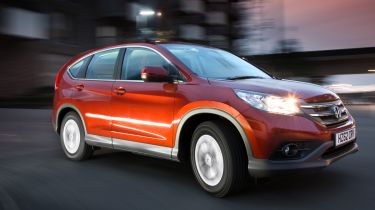Honda CR-V 2.0-litre petrol 2WD SE
New Honda CR-V is available with two-wheel drive for the first time

The new CR-V isn’t particularly exciting to look at, and the driving experience is certainly designed more for the comfort of passengers than for a keen driver. The interior is very spacious, though, and feels like there’s storage for just about anything, from a mobile phone to the kitchen sink. The new 2WD does expand the CR-V’s appeal, but the running costs mean that the better-equipped diesel four-wheel drive models make more sense, even though they cost more to buy.
Economic doom or not, the UK’s appetite for soft roaders continues unabated. But, while Honda was one of the first to the SUV that drives like a car niche back in 1997, new rivals like the Nissan Qashqai and Ford Kuga have meant that the Japanese firm has constantly had to evolve to keep up with the pack.
Step forward the new, British-built fourth-generation CR-V, which is available with front-wheel drive in the UK for the first time. But is it any good?
The two-wheel drive model will form the entry point to the new range, and, initially, will only be available with a 153bhp 2.0-litre petrol engine coupled to a six-speed manual gearbox. The engine is carried over from the previous car, albeit with a 5bhp increase in power, while CO2 falls from 192g/km to 168g/km thanks to the addition of stop-start.
Used - available now
The new CR-V looks much more dynamic than its predecessor, with a more rakish design dominating the exterior. Honda has mixed understated styling details like the crease running along its flanks, with more outlandish flourishes like the LED taillights, doing just enough to make the newcomer stand out.
Inside, the mix of materials has improved and equipment is generous – the two-wheel drive model is only available in base or second-up S or SE trims, but that still includes 17-inch alloys, climate control, cruise control and USB connectivity.
But what’s more impressive is the space, and feeling of spaciousness, available inside. Front seat passengers get ample storage, more adjustability for the seat and steering wheel and a large centre console bin, while the flat floor allows three adults to sit in comfort in the rear.
The boot has been made larger, with a lower loading lip, making it easier to get heavy items on board. The rear seats also fold flat by simply pulling a lever in the boot or under the side of the bench.
Get behind the wheel and the driving experience is almost identical to the four-wheel drive model, which directs power to the front wheels most of the time anyway. In fact, the revised electronic 4WD system only increases the CO2 figure to 173g/km, giving an idea of how little the rear axle demands from the engine.
The steering - now fully electrically assisted - is fairly lifeless but you still retain confidence in the car’s ability to negotiate bends at speed. Likewise, the retuned dampers give a smooth and compliant ride, but offer less for the keen driver as bodyroll becomes an issue.
The 2.0-litre engine is extremely smooth and revs freely, while the six-speed manual snicks between gears smoothly, too. Under normal driving, the petrol engine is extremely quiet, which draws attention to the roar from the tyres.
The arrival of a two-wheel-drive model has allowed Honda to broaden the appeal of the CR-V, right at a time when the soft roader market is becoming ever more competitive.
However, while the petrol engine is a satisfying unit, the lack of a 2WD diesel option means that, unless price is an issue, opting for the diesel model is a better bet, thanks to its 350Nm of torque, lower CO2 emissions and lower thirst for fuel.











